 |
 |
 How to travel along the How to travel along the
 Louisiana? Louisiana?
 Master piece by Filip Master piece by Filip
 Vukasović Vukasović
 On the road admired by the On the road admired by the
 whole of Europe whole of Europe
 Settlements along the Settlements along the
 Louisiana Louisiana
 Stay a few days longer, Stay a few days longer,
 enjoy in the nature so rich enjoy in the nature so rich
 in wild romantics in wild romantics
 Move slowly along Move slowly along
 Lousiana like the first Lousiana like the first
 travellers did travellers did
 >
Louisiana Map - >
Louisiana Map -
 Four Districts Four Districts
 Did you know? Did you know?
 Celebrities Celebrities |
 |
THE LOKVE -
DELNICE DISTRICT
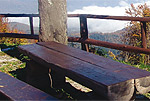 You will easily recognize the entry into the Lokve-Delnice District where dense coniferous woods replace the bare rocky ground. In the fifties of the past century part of the old Louisiana found itself at the You will easily recognize the entry into the Lokve-Delnice District where dense coniferous woods replace the bare rocky ground. In the fifties of the past century part of the old Louisiana found itself at the
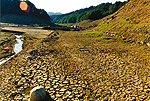 bottom of the artificial lake (the Lake of Lokve), and a new route was constructed above it. It is worth following the old Louisiana route, from Jelenje through Mrzle Vodice up to Lokve. Namely it is only here and in the Karlovac District that the Louisiana exhibits such a concentration of curbstones, underpinning masonry and drains. bottom of the artificial lake (the Lake of Lokve), and a new route was constructed above it. It is worth following the old Louisiana route, from Jelenje through Mrzle Vodice up to Lokve. Namely it is only here and in the Karlovac District that the Louisiana exhibits such a concentration of curbstones, underpinning masonry and drains.
Until the construction of Louisiana there were almost no other settlements, apart from Lokve and Delnice. General Vukasović traced a road here, through dense coniferous woods, giving thus a boost to timber exploitation, to the construction of saw-mills, and the inhabitants became skilful in wood processing.
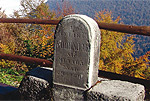 Brigands who had found shelter in the dense woods of the Lokve-Delnice area also “came into their own”. Stories about brigands' attacks were frequently retold in the inns, especially when some timorous traveler stopped by, then the brigands would become the favourite topic.
The Lokve-Delnice District abounds in places worth visiting, therefore plan to stay at least one, preferably two or three days there. Brigands who had found shelter in the dense woods of the Lokve-Delnice area also “came into their own”. Stories about brigands' attacks were frequently retold in the inns, especially when some timorous traveler stopped by, then the brigands would become the favourite topic.
The Lokve-Delnice District abounds in places worth visiting, therefore plan to stay at least one, preferably two or three days there.
ON LOUISIANA
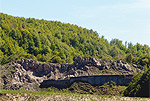 When you pass Gornje Jelenje, you will come across a steep ascent and the village Lepenice, whose inhabitants used to live well on «quartering» – they rented their strong horses and bullocks to carters of heavily loaded carts traveling along the Mrzle Vodice - Gornje Jelenje section. In Lepenice fine folk and well-off merchants liked to stop by at Tijan's inn and lodging. In Ravno Podolje you will see the altimeter of the Louisiana road and be able to admire the magnificent view extending to the East. When you pass Gornje Jelenje, you will come across a steep ascent and the village Lepenice, whose inhabitants used to live well on «quartering» – they rented their strong horses and bullocks to carters of heavily loaded carts traveling along the Mrzle Vodice - Gornje Jelenje section. In Lepenice fine folk and well-off merchants liked to stop by at Tijan's inn and lodging. In Ravno Podolje you will see the altimeter of the Louisiana road and be able to admire the magnificent view extending to the East.
Lokve was given special impetus by the construction of Louisiana. In Mala voda you must visit the wonderful stone-arched bridge.
If you wish to learn more about the way in which Gorski kotar inhabitants lived in touch with nature, woods and Louisiana, be sure to visit the ethnological exhibition and the Frogs' Museum in Lokve.
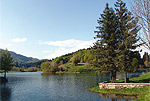 The Louisiana Society placed its third main toll-gate in Delnice. In the area called Grabanj the Louisiana builders faced major difficulties in bridging the great ditch, and the beautiful bridge they built here gives evidence to this today. A bit above Delnice, on Veliki vodenjak there is The Louisiana Society placed its third main toll-gate in Delnice. In the area called Grabanj the Louisiana builders faced major difficulties in bridging the great ditch, and the beautiful bridge they built here gives evidence to this today. A bit above Delnice, on Veliki vodenjak there is
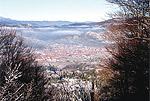 still a preserved altimeter. Do not miss to visit the three hundred year old house Rački and the Popović mill in Delnice. If you wish to spend a few more hours here, we suggest a walk through the park-forest Japlenški vrh or the mild ascent to Petehovac and the mountain plateau Polane, where the local inhabitants used to have their summer stock-breeders' quarters. still a preserved altimeter. Do not miss to visit the three hundred year old house Rački and the Popović mill in Delnice. If you wish to spend a few more hours here, we suggest a walk through the park-forest Japlenški vrh or the mild ascent to Petehovac and the mountain plateau Polane, where the local inhabitants used to have their summer stock-breeders' quarters.
The Lokvarka Cave
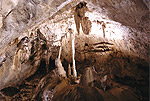 Unveils underground secrets of spacious halls with stairs and bridges overlooking the precipice in the cave. The local population renovated the cave as early as the beginning of the 20th century, when numerous guests used to come here to benefit from the healthy and fresh mountain air. Unveils underground secrets of spacious halls with stairs and bridges overlooking the precipice in the cave. The local population renovated the cave as early as the beginning of the 20th century, when numerous guests used to come here to benefit from the healthy and fresh mountain air.
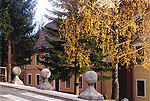 The Lokve lake The Lokve lake
Its bottom conceals part of the Louisiana route, with the Emperor's Bridge across Mrzle Vodice, that was flooded over in the fifties in order to construct this artificial lake. The mile-stone drowned in Homer was rescued by the local inhabitants and today is exhibited in front of the local elementary school, just like the ornaments of the bridge in Mala voda.
Take a walk or ride a bicycle along the shores of the lake. If you need refreshment, enjoy in the Gorski kotar specialties offered in the nearby restaurants.
Golubinjak
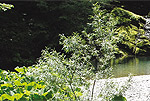 If you wish to rest in the shade of a dense spruce wood, Golubinjak is your next destination. Here promenades and belvederes will welcome you, while the caves Golubinja and Ledena spilja expect adventure lovers, just like the giant «queen of the forest», a 200-year old fir tree. Look for the remnants of the well-trodden Frankopan caravan routes and visit the sculptures park. If you wish to rest in the shade of a dense spruce wood, Golubinjak is your next destination. Here promenades and belvederes will welcome you, while the caves Golubinja and Ledena spilja expect adventure lovers, just like the giant «queen of the forest», a 200-year old fir tree. Look for the remnants of the well-trodden Frankopan caravan routes and visit the sculptures park.
Vražji prolaz and Zeleni Vir
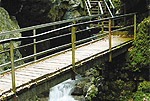 Near Skrad, the seventy-metre high cascade, the three kilometres long, narrow canyon with the roaring mountain stream and Muževa spilja – cave - at the end of the canyon, where the local population found shelter from Turkish aggression, are three good reasons for visiting this attraction. Paths, stairs and bridges lead through Vražji prolaz, that in some spots is just two metres wide. At the entrance stands the climbers' lodging with restaurant and an arranged picnic space.
Come closer, get to know us better Near Skrad, the seventy-metre high cascade, the three kilometres long, narrow canyon with the roaring mountain stream and Muževa spilja – cave - at the end of the canyon, where the local population found shelter from Turkish aggression, are three good reasons for visiting this attraction. Paths, stairs and bridges lead through Vražji prolaz, that in some spots is just two metres wide. At the entrance stands the climbers' lodging with restaurant and an arranged picnic space.
Come closer, get to know us better
Čabar
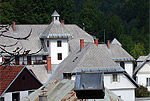 Today the Čabar inhabitants pride themselves on living in the greenest town of Croatia, but 400 years ago their ancestors lived in a ferrous metallurgy centre. In the surroundings of Čabar iron ore used to be mined, so that the Zrinskis built an ironworks in Čabar, employing more than 200 workers there. Masters in iron ore melting and processing came even from Bohemia, and the Today the Čabar inhabitants pride themselves on living in the greenest town of Croatia, but 400 years ago their ancestors lived in a ferrous metallurgy centre. In the surroundings of Čabar iron ore used to be mined, so that the Zrinskis built an ironworks in Čabar, employing more than 200 workers there. Masters in iron ore melting and processing came even from Bohemia, and the 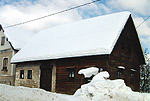 factory consisted of seven buildings, a mill, a saw-mill, the administration building and the residential building for the Zrinskis. factory consisted of seven buildings, a mill, a saw-mill, the administration building and the residential building for the Zrinskis.
Although the ironworks closed by the end of the 18th century, the Zrinski castle still dominates Čabar, with the Vilim Svečnjak gallery, the ethnological and the hunting collections located there. In the Čabar area take a walk to the source of the Čabranka river, or take a drive to Prezid to visit the late antiquity limes – the remains of the Western Roman Empire defense walls - after which Prezid got its name.
STAY
a few days longer and set off to the north of Louisiana
National Park Risnjak and Kupa source
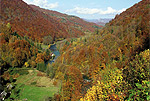 You will find yourself breathing deeply the fresh mountain air and abandoning yourself to the beauty, the sounds and the fragrances of untouched nature. Get to know the life of nature and of the people on the instructive path Leska (entry Crni Lug) or climb to the peak of Risnjak, one of the most beautiful mountain peaks in Croatia. At the village Razloge descend to the Kupa source, where crystal clear cold water flows incessantly out of the underground source. You will find yourself breathing deeply the fresh mountain air and abandoning yourself to the beauty, the sounds and the fragrances of untouched nature. Get to know the life of nature and of the people on the instructive path Leska (entry Crni Lug) or climb to the peak of Risnjak, one of the most beautiful mountain peaks in Croatia. At the village Razloge descend to the Kupa source, where crystal clear cold water flows incessantly out of the underground source.
Brod na Kupi
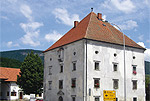 In ancient times vessels transported people and goods here, hence the name of the place (Brod na Kupi = Vessel on Kupa). The place is dominated by the 15th century Zrinski castle , but until the construction of Louisiana, on which the local population worked and through which they exported their products to the coast (Primorje), life was very hard here.
If you stop at Velika and Mala Lešnica, on the road between Delnice and Brod, you will learn how the local population used to live and organize their economy. In ancient times vessels transported people and goods here, hence the name of the place (Brod na Kupi = Vessel on Kupa). The place is dominated by the 15th century Zrinski castle , but until the construction of Louisiana, on which the local population worked and through which they exported their products to the coast (Primorje), life was very hard here.
If you stop at Velika and Mala Lešnica, on the road between Delnice and Brod, you will learn how the local population used to live and organize their economy.
Brod Moravice
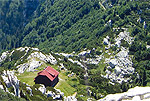 By the end of the 18th century river waterways were built throughout Europe. In order to keep pace with this traffic development trend, Empress Maria Theresa joined the 'fashion'.
The intent was to build a By the end of the 18th century river waterways were built throughout Europe. In order to keep pace with this traffic development trend, Empress Maria Theresa joined the 'fashion'.
The intent was to build a
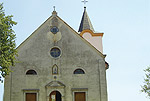 waterway from Karlovac to Brod na Kupi, and therefrom a road to Rijeka. Works on the waterway began near Brod na Kupi, in 1801. waterway from Karlovac to Brod na Kupi, and therefrom a road to Rijeka. Works on the waterway began near Brod na Kupi, in 1801.
After the Society had spent half a million forints to build ten
kilometres of a waterway with uncertain outcomes, Filip Vukasović -
renowned architect of the time - was consulted, and he suggested to
interrupt the works and to build a modern mountain roadway instead.
I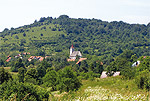 f there are any curious spirits among you, you can look for the traces of this utopian venture in the vicinity of the village Doluš, in the hamlet Binički – the canal is about a hundred metres long, three metres wide, fixed by drywalls with stone blocks weighing even up to one ton. Downstream of Doluš there is another canal, some 500 m long, and 800 m of the banks are lined with dug stone. f there are any curious spirits among you, you can look for the traces of this utopian venture in the vicinity of the village Doluš, in the hamlet Binički – the canal is about a hundred metres long, three metres wide, fixed by drywalls with stone blocks weighing even up to one ton. Downstream of Doluš there is another canal, some 500 m long, and 800 m of the banks are lined with dug stone.
If you head off for Doluš, do not miss to stop by in the neighbouring villages Delače, Maklen, Moravičko Selo, Kuti, Colnare, they have retained the authentic Gorski kotar rural architecture and are therefore real small museums in the open, while one of the medieval rural houses in the village has been renovated and opened to visitors.
Stay several days longer and set off to the south of Louisiana
Fužine
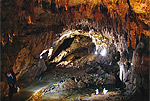 This is one of the old Gorski kotar settlements where, judging by the name that originates from the Italian word Fucina (blacksmith's workshop), iron ore once used to be mined and melted. Fužine prospered, first with the construction of Carolina and then of Louisiana, to which the locality was linked by a special branch line. The Fužine inhabitants realized very quickly that the place could benefit from the travelers and from those coming for health purposes. And indeed, today this is one of the best organized localities in the Gorski kotar area. Enjoy on the shores of lake Bajer, visit the Vrelo cave, taste the typical Gorski kotar dishes in the local restaurants. To those who wish to learn more about life in this area in the course of the past centuries we suggest to drive to Lič and visit the county collection as well as the sanctuary of Our Lady of the Snow who, as the legend goes, appeared to the peasants in the terrible storm of 1733, and saved them from the bad weather. This is one of the old Gorski kotar settlements where, judging by the name that originates from the Italian word Fucina (blacksmith's workshop), iron ore once used to be mined and melted. Fužine prospered, first with the construction of Carolina and then of Louisiana, to which the locality was linked by a special branch line. The Fužine inhabitants realized very quickly that the place could benefit from the travelers and from those coming for health purposes. And indeed, today this is one of the best organized localities in the Gorski kotar area. Enjoy on the shores of lake Bajer, visit the Vrelo cave, taste the typical Gorski kotar dishes in the local restaurants. To those who wish to learn more about life in this area in the course of the past centuries we suggest to drive to Lič and visit the county collection as well as the sanctuary of Our Lady of the Snow who, as the legend goes, appeared to the peasants in the terrible storm of 1733, and saved them from the bad weather.
Mrkopalj
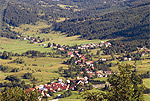 This beautiful, extended mountain settlement developed by the end of the 18th century, with the construction of Carolina. With as many as seven thousand inhabitants, the parish church and the school, this was the biggest settlement in Gorski kotar. Here settled inhabitants from the Croatian Littoral (Primorje), Carniola (Kranjska), and even Bohemia. This beautiful, extended mountain settlement developed by the end of the 18th century, with the construction of Carolina. With as many as seven thousand inhabitants, the parish church and the school, this was the biggest settlement in Gorski kotar. Here settled inhabitants from the Croatian Littoral (Primorje), Carniola (Kranjska), and even Bohemia.
If you happen to come to Mrkopalj, pay a visit to Brestova Draga where Matija Weiss, the builder of Carolina, decided to construct a big viaduct. This long and steep bridge is mounted on 13 erected buttresses (so called «fajeri» from the Germa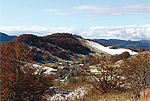 n word Pfeiler – post or pillar) of pyramidal form, that supported the wooden construction. However, in one incident, a stage-coach fell down the precipice from the frozen bridge and all its passengers lost their lives. Shortly after this grievous event the architect Weiss committed suicide. n word Pfeiler – post or pillar) of pyramidal form, that supported the wooden construction. However, in one incident, a stage-coach fell down the precipice from the frozen bridge and all its passengers lost their lives. Shortly after this grievous event the architect Weiss committed suicide.
In the vicinity of Mrkopalj lies Begovo Razdolje – the highest village in Croatia, situated 1.078 metres above sea level. Begovo Razdolje is the departure point for marches to Bjelolasica, one of our most beautiful mountains and a famous skiing resort. In the surroundings of Mrkopalj, on Matić-poljana, on the road leading to Jasenak, there are 26 monolithic limestone rocks approximate two metres high. They are a monument to the partisans who froze in the winter storm, during a march, in 1944.
Ravna Gora
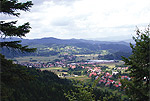 Ravna Gora, an extended settlement situated along the Carolina road, recalls the charm of past times when the dialects from Primorje, Bohemia, Carniola whirred along the road and when the people gathered, from all sides, to visit the Ravna gora fairs. If you believe in legends you must visit the well Božji studenac on Javorova kosa because, according to the legend, its water heals all those suffering from eye problems. On the estate of the Juretić family, in adjacent Leskova Draga, time seems to have stopped more than one hundred years ago. The old saw mill and the water-powered mill must certainly be visited. Ravna Gora, an extended settlement situated along the Carolina road, recalls the charm of past times when the dialects from Primorje, Bohemia, Carniola whirred along the road and when the people gathered, from all sides, to visit the Ravna gora fairs. If you believe in legends you must visit the well Božji studenac on Javorova kosa because, according to the legend, its water heals all those suffering from eye problems. On the estate of the Juretić family, in adjacent Leskova Draga, time seems to have stopped more than one hundred years ago. The old saw mill and the water-powered mill must certainly be visited.
|
 |



